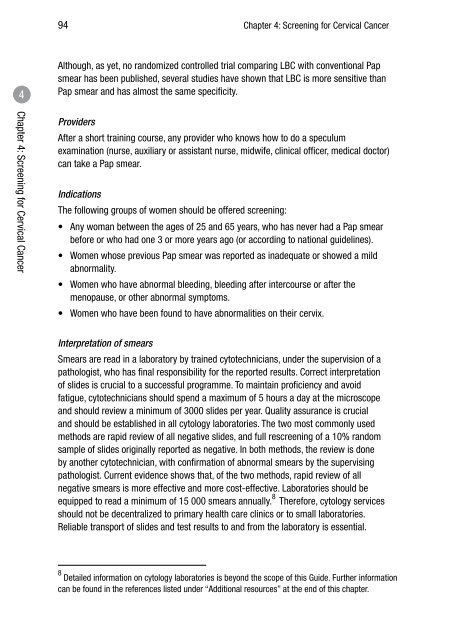CHAPTER 4: SCREENING FOR CERVICAL CANCER
CHAPTER 4: SCREENING FOR CERVICAL CANCER
CHAPTER 4: SCREENING FOR CERVICAL CANCER
Create successful ePaper yourself
Turn your PDF publications into a flip-book with our unique Google optimized e-Paper software.
94Chapter 4: Screening for Cervical Cancer4Although, as yet, no randomized controlled trial comparing LBC with conventional Papsmear has been published, several studies have shown that LBC is more sensitive thanPap smear and has almost the same specificity.Chapter 4: Screening for Cervical CancerProvidersAfter a short training course, any provider who knows how to do a speculumexamination (nurse, auxiliary or assistant nurse, midwife, clinical officer, medical doctor)can take a Pap smear.IndicationsThe following groups of women should be offered screening:• Any woman between the ages of 25 and 65 years, who has never had a Pap smearbefore or who had one 3 or more years ago (or according to national guidelines).• Women whose previous Pap smear was reported as inadequate or showed a mildabnormality.• Women who have abnormal bleeding, bleeding after intercourse or after themenopause, or other abnormal symptoms.• Women who have been found to have abnormalities on their cervix.Interpretation of smearsSmears are read in a laboratory by trained cytotechnicians, under the supervision of apathologist, who has final responsibility for the reported results. Correct interpretationof slides is crucial to a successful programme. To maintain proficiency and avoidfatigue, cytotechnicians should spend a maximum of 5 hours a day at the microscopeand should review a minimum of 3000 slides per year. Quality assurance is crucialand should be established in all cytology laboratories. The two most commonly usedmethods are rapid review of all negative slides, and full rescreening of a 10% randomsample of slides originally reported as negative. In both methods, the review is doneby another cytotechnician, with confirmation of abnormal smears by the supervisingpathologist. Current evidence shows that, of the two methods, rapid review of allnegative smears is more effective and more cost-effective. Laboratories should beequipped to read a minimum of 15 000 smears annually. 8 Therefore, cytology servicesshould not be decentralized to primary health care clinics or to small laboratories.Reliable transport of slides and test results to and from the laboratory is essential.8 Detailed information on cytology laboratories is beyond the scope of this Guide. Further informationcan be found in the references listed under “Additional resources” at the end of this chapter.
















